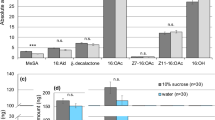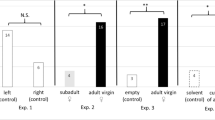Abstract
Male Pieris napi butterflies previously have been shown to synthesize and transfer an antiaphrodisiac, methyl salicylate (MeS), to females at mating. This substance curtails courtship and decreases the likelihood of female remating. Here, we show that similar systems occur in Pieris rapae and Pieris brassicae. In P. rapae, 13C-labeling studies showed that males utilize the amino acids phenylalanine and tryptophan as precursors to MeS and indole, respectively. These volatiles are transferred to females at mating and function as antiaphrodisiacs, as demonstrated by field tests entailing painting MeS, indole, or a mixture on the abdomens of virgin females and assessing their attractiveness to wild males. With P. brassicae, 13C-labeling studies showed that males use phenylalanine as a precursor to synthesize benzyl cyanide, which was demonstrated to function as an antiaphrodisiac by field tests similar to those for P. rapae. This communication system exhibits both similarities and differences among the three species; in P. napi and P. rapae, males are fragrant but transfer a volatile antiaphrodisiac to females that is completely different from the male odor, whereas in P. brassicae the antiaphrodisiac transferred by male to female is identical with male odor.
Similar content being viewed by others
References
Andersson, J., Borg-Karlson, A. K., and Wiklund, C. 2000. Sexual cooperation and conflict in butterflies: A male-transferred anti-aphrodisiac reduces harassment of recently mated females. Proc. R. Soc. London B 267:1271.
Bissondath, C. and Wiklund, C. 1997. Effect of male body size on sperm precedence in the polyandrous butterfly Pieris napi. Behav. Ecol. 5:518–523.
Boggs, C. L. and Gilbert, L. E. 1979. Male contribution to egg production in butterflies: Evidence for transfer of nutrients at mating. Science 206:83–84.
Borg-Karlson, A. K. and Mozuraitis, R. 1996. Solid phase micro extraction technique used for collecting semiochemicals: Identification of volatiles released by individual signalling Phyllonorycter sylvella moths. Z. Naturforsch. 51c:599–602.
Burns, J. M. 1968. Mating frequency in natural populations of skippers and butterflies as determined by spermatophore counts. Proc. Natl. Acad. Sci. U.S.A. 61:852–859.
Drummond, B. A. III. 1984. Multiple mating and sperm competition in the Lepidoptera, pp. 291-370, in R. L. Smith (ed.). Sperm Competition and the Evolution of Animal Mating Systems. Academic Press, London.
Ehrlich, A. H. and Ehrlich, P. R. 1978. Reproductive strategies in the butterflies: I. Mating frequency, plugging, and egg number. J. Kansas Entomol. Soc. 51:666–697.
Forsberg, J. and Wiklund, C. 1989. Mating in the afternoon: Time-saving in courtship and remating by females of a polyandrous butterfly. Pieris napi. Behav. Ecol. Sociobiol. 25:349–356.
Gilbert, L. E. 1976. Postmating female odor in Heliconius butterflies: A male-contributed antiaphrodisiac? Science 193:419–420.
Happ, G. M. 1969. Multiple sex pheromones of the mealworm beetle, Tenebrio molitor L. Nature 222:180–181.
Kaitala, A. and Wiklund, C. 1994. Polyandrous females forage for matings. Behav. Ecol. Sociobiol. 35:385–388.
Kaitala, A. and Wiklund C. 1995. Female mate choice and mating costs in the polyandrous butterfly Pieris napi (Lepidoptera: Pieridae). J. Insect Behav. 8:355–363.
Karlsson, B. 1998. Nuptial gifts, resource budgets, and reproductive output in a polyandrous butterfly. Ecology 79:2931–2940.
Obara, Y. 1964. Mating behaviour of the cabbage white, Pieris rapae crucivora II: The “mate-refusal” posture of the female. Zool. Mag. 73:175–178.
Parker, G. A. 1970. Sperm competition and its evolutionary consequences in the insects. Biol. Rev. 45:525–567.
Silberglied, R. E. 1984. Visual communication and sexual selection among butterflies, pp. 207-223, in R. I. Vane-Wright and P. R. Ackery (Eds.). The Biology of Butterflies. Academic Press, London.
Sväard, L. and Wiklund, C. 1989. Mass and production rate of ejaculates in relation to monandry/polyandry in butterflies. Behav. Ecol. Sociobiol. 24:395–402.
Wedell, N. and Cook, P. A. 1998. Determinants of paternity in a butterfly. Proc. R. Soc. London B 265:625–630.
Wiklund, C. and Forsberg, J. 1985. Courtship and male discrimination between virgin and mated females in the orange tip butterfly, Anthocharis cardamines. Anim. Behav. 34:328–332.
Wiklund, C. and Forsberg, J. 1991. Sexual size dimorphism in relation to female polygamy and protandry in butterflies: A comparative study of Swedish Pieridae and Satyridae. Oikos 60:373–381.
Wiklund, C., Kaitala, A., Lindfors, V., and Abenius, J. 1993. Polyandry and its effect on female reproduction in the green-veined white butterfly (Pieris napi L.). Behav. Ecol. Sociobiol. 33:25–33.
Wiklund, C., Kaitala, A., and Wedell, N. 1998. Reproductive rates in relation to male and female parental expenditure in a polyandrous butterfly(Pieris napi L.) with large male nuptial gifts. Behav. Ecol. 9:20–25.
Author information
Authors and Affiliations
Corresponding author
Rights and permissions
About this article
Cite this article
Andersson, J., Borg-Karlson, AK. & Wiklund, C. Antiaphrodisiacs in Pierid Butterflies: A Theme with Variation!. J Chem Ecol 29, 1489–1499 (2003). https://doi.org/10.1023/A:1024277823101
Issue Date:
DOI: https://doi.org/10.1023/A:1024277823101




